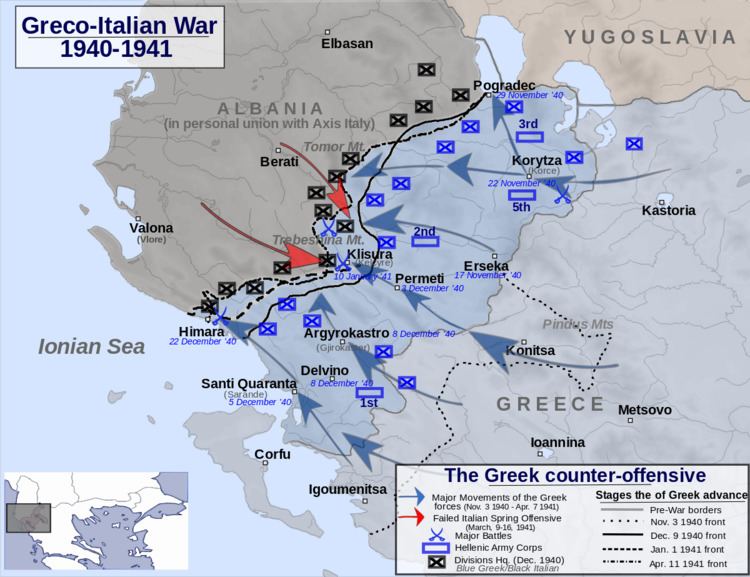9 divisions 6 divisions Result Greek victory | Dates 9 Mar 1941 – 16 Mar 1941 | |
 | ||
11,800 total 1,243 killed
42 missing
4,116 wounded
Total 5,401 Similar Greco‑Italian War, Capture of Klisura Pass, Battle of Pindus, Battle of Himara, Battle of Trebeshina | ||
The Italian Spring Offensive, also known as Operazione Primavera (Operation Spring), was an offensive of the Greco-Italian War that lasted from 9 to 16 March 1941. The offensive was the last Italian attempt of the war to defeat the Greek forces, which had already advanced deep into Albanian territory. The opening of the offensive was supervised by the Italian dictator Benito Mussolini but ended a week later in complete failure.
Contents
Background
On 28 October 1940, Fascist Italy declared war upon Greece. The Italian 9th Army and 11th Army invaded north-west Greece from Albania. They were soon pushed back and the Greek army launched a counter-attack deep into Albanian territory. In February 1941, intensive preparations to strengthen the Italian front line began. By the end of the month, the 15 Italian divisions fighting in Albania had been reinforced by an additional ten divisions. In order to raise the morale of the soldiers, Benito Mussolini ordered the units to be accompanied by the most aggressive fascist cadres and also by government ministers and high-ranking officials.
Prelude
The operation was to be directed and observed by Mussolini, who arrived in Tirana on 2 March 1941; Italian radio announced that Mussolini lead the Italian attack. Operazione Primavera, the spring offensive began on 9 March, under General Carlo Geloso and started with heavy bombardment of Greek positions by artillery and aircraft. Eleven infantry divisions attacked with the support of the 131st Armoured Division Centauro.
The attack was mainly directed against the 1st, 2nd, 5th, 11th, 15th and 17th divisions of the Greek army and was followed by repeated infantry assaults between the rivers Osum and Vjosë, an area dominated by Trebeshinë. On 14 March, Italian General Ugo Cavallero, realizing that the attacks had failed, advised Mussolini to stop the offensive. Fierce fighting occurred on height 731, which was assaulted by the Italians at least 18 times. The Greek forces maintained an active defence, which included counter-attacks and systematic exploitation of advantageous terrain. Decisive factors in the Greek success were that Greek artillery was not neutralized and the high morale of the Greek troops.
Aftermath
After the Italian failure the Germans could no longer expect any appreciable support from their Italian allies when they marched against Greece, since Greek forces were only 16 kilometres (10 mi) away from the strategic port of Vlorë. With the German intervention and the subsequent capitulation of Greece in April 1941, the sector around height "731" was proclaimed a holy area by the Italians and a monument was erected by them, due to the heavy casualties they suffered.
